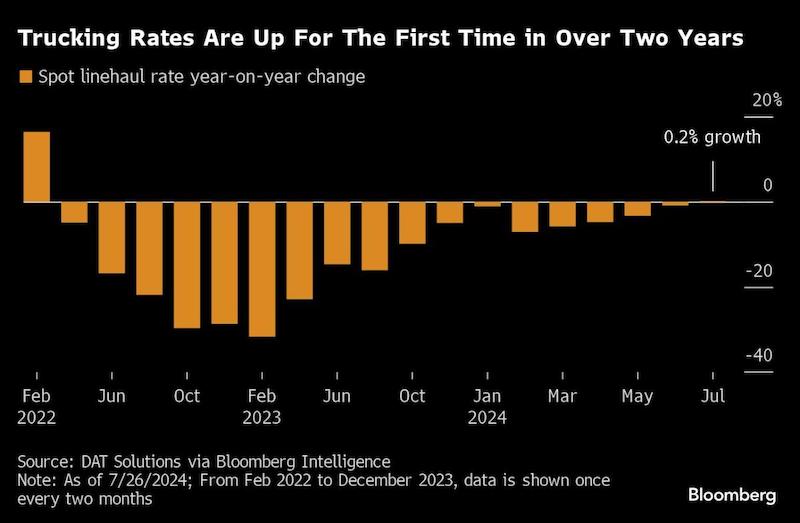Optimism Grows in US Trucking Sector Amid Anticipated Uptick in Freight Rates
US trucking executives are expressing optimism that their recession may soon end as freight rates are poised to increase for the first time in nearly two years. The average cost of transporting goods by truck is expected to rise by 0.2% year-over-year this month, following 27 consecutive months of decline, according to freight marketplace DAT Solutions. Demand appears to be returning to pre-pandemic levels, with trucking executives predicting a recovery as their stock prices climb.
“If the trends over the past few months continue, we should see demand building as we exit the third quarter and some return of seasonal activity for the fourth quarter for the first time in years,” said Adam Miller, Chief Executive Officer of Knight-Swift Transportation Holdings Inc., during a recent earnings call.
Investor optimism is evident as the Russell 3000 Trucking Index, which includes 16 members such as JB Hunt Transport Services Inc. and Old Dominion Freight Line Inc., increased by 9% this month as of Thursday’s close, recovering from a nearly 8% drop in the first half of the year.
This positive outlook suggests that one of the last industries still struggling with pandemic-related disruptions may finally be on the road to recovery. Freight rates began to decline in early 2022 as American consumers emerged from Covid-19 restrictions and shifted their spending from online shopping sprees to services, travel, and experiences. This sudden change left retailers with excess inventory, reducing the need for trucks to haul new orders.
“We seem to be coming out of that contractionary period that we were in for 26 or 27 months,” said Ken Adamo, DAT Solutions’ analytics chief, in a phone interview.
Retailers are gradually clearing their inventories, and some have expedited shipments to avoid delays caused by backlogs at ports in Asia and the Mediterranean, as well as dockworker strikes in the US. JB Hunt reported a double-digit increase in intermodal volume—transporting freight from train to truck—in Southern California during the second quarter, partly due to customers placing advance orders.
However, some carriers and analysts are tempering expectations, noting that profits are unlikely to suddenly return to pandemic-era highs. Manufacturing activity remains low, consumers are facing financial challenges, and there is still an oversupply of trucks.
The number of truck drivers on the road in the US has increased by as much as 14% since March 2020, while freight volumes have risen by only 4% over a similar period, according to freight consultancy FTR Trucking. Additionally, when goods arrive in the US, retailers prefer to use rail for transportation because it is more cost-effective.
“We’re at the beginning stages of what we hope will be a recovery in the industry, not in the later stages,” said Robert Costello, chief economist at the American Trucking Associations, in a phone interview.
Source: Bloomberg














